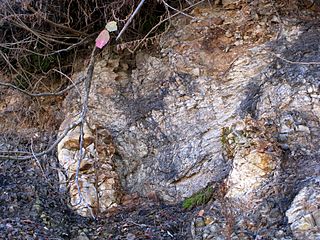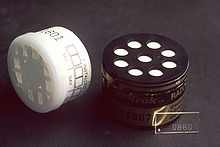Background radiation is a measure of the level of ionizing radiation present in the environment at a particular location which is not due to deliberate introduction of radiation sources.

Radon is a chemical element; it has symbol Rn and atomic number 86. It is a radioactive noble gas and is colorless and odorless. Of the three naturally occurring radon isotopes, only radon-222, has a sufficiently long half-life for it to be released from the soil and rock where it is generated. Radon isotopes are the immediate decay products of radium isotopes. The instability of radon-222, its most stable isotope, makes radon one of the rarest elements. Radon will be present on Earth for several billion more years, despite its short half-life, because it is constantly being produced as a step in the decay chain of uranium-238, and that of thorium-232, each of which is an extremely abundant radioactive nuclide with a half-life of several billion years. The decay of radon produces many other short-lived nuclides, known as "radon daughters", ending at stable isotopes of lead. Radon-222 occurs in significant quantities as a step in the normal radioactive decay chain of uranium-238, also known as the uranium series, which slowly decays into a variety of radioactive nuclides and eventually decays into lead-206, which is stable. Radon-220 occurs in minute quantities as an intermediate step in the decay chain of thorium-232, also known as the thorium series, which eventually decays into lead-208, which is stable.

Heating, ventilation, and air conditioning (HVAC) is the use of various technologies to control the temperature, humidity, and purity of the air in an enclosed space. Its goal is to provide thermal comfort and acceptable indoor air quality. HVAC system design is a subdiscipline of mechanical engineering, based on the principles of thermodynamics, fluid mechanics, and heat transfer. "Refrigeration" is sometimes added to the field's abbreviation as HVAC&R or HVACR, or "ventilation" is dropped, as in HACR.

Indoor air quality (IAQ) is the air quality within buildings and structures. Poor indoor air quality due to indoor air pollution is known to affect the health, comfort, and well-being of building occupants. It has also been linked to sick building syndrome, respiratory issues, reduced productivity, and impaired learning in schools. Common pollutants of indoor air include: secondhand tobacco smoke, air pollutants from indoor combustion, radon, molds and other allergens, carbon monoxide, volatile organic compounds, legionella and other bacteria, asbestos fibers, carbon dioxide, ozone and particulates. Source control, filtration, and the use of ventilation to dilute contaminants are the primary methods for improving indoor air quality.
Chlordane, or chlordan, is an organochlorine compound that was used as a pesticide. It is a white solid. In the United States, chlordane was used for termite-treatment of approximately 30 million homes until it was banned in 1988. Chlordane was banned 10 years earlier for food crops like corn and citrus, and on lawns and domestic gardens.
Sick building syndrome (SBS) is a condition in which people develop symptoms of illness or become infected with chronic disease from the building in which they work or reside. In the scientific literature, SBS is also known as Building Related Illness (BRI) or Building Related Symptoms (BRS) or Idiopathic Environmental Intolerance (IEI).

Ventilation is the intentional introduction of outdoor air into a space. Ventilation is mainly used to control indoor air quality by diluting and displacing indoor pollutants; it can also be used to control indoor temperature, humidity, and air motion to benefit thermal comfort, satisfaction with other aspects of the indoor environment, or other objectives.

A humidifier is a household appliance or device designed to increase the moisture level in the air within a room or an enclosed space. It achieves this by emitting water droplets or steam into the surrounding air, thereby raising the humidity.

Radium Hot Springs, informally and commonly called Radium, is a village of 1,339 residents in the East Kootenay region of British Columbia. The village is named for the hot springs in the nearby Kootenay National Park. From Banff, Alberta, it is accessible via Highway 93.

Radium and radon are important contributors to environmental radioactivity. Radon occurs naturally as a result of decay of radioactive elements in soil and it can accumulate in houses built on areas where such decay occurs. Radon is a major cause of cancer; it is estimated to contribute to ~2% of all cancer related deaths in Europe.

Passive ventilation is the process of supplying air to and removing air from an indoor space without using mechanical systems. It refers to the flow of external air to an indoor space as a result of pressure differences arising from natural forces.

A crawl space or crawlspace is an unoccupied, unfinished, narrow space within a building, between the ground and the first floor. The crawl space is so named because there is typically only enough room to crawl rather than stand; anything larger than about 1 to 1.5 metres and beneath the ground floor would tend to be considered a basement.

Indoor mold or indoor mould, also sometimes referred to as mildew, is a fungal growth that develops on wet materials in interior spaces. Mold is a natural part of the environment and plays an important part in nature by breaking down dead organic matter such as fallen leaves and dead trees; indoors, mold growth should be avoided. Mold reproduces by means of tiny spores. The spores are like seeds, but invisible to the naked eye, that float through the air and deposit on surfaces. When the temperature, moisture, and available nutrient conditions are correct, the spores can form into new mold colonies where they are deposited. There are many types of mold, but all require moisture and a food source for growth.
HVAC is a major sub discipline of mechanical engineering. The goal of HVAC design is to balance indoor environmental comfort with other factors such as installation cost, ease of maintenance, and energy efficiency. The discipline of HVAC includes a large number of specialized terms and acronyms, many of which are summarized in this glossary.
Indoor bioaerosol is bioaerosol in an indoor environment. Bioaerosols are natural or artificial particles of biological origin suspended in the air. These particles are also referred to as organic dust. Bioaerosols may consist of bacteria, fungi, viruses, microbial toxins, pollen, plant fibers, etc. Size of bioaerosol particles varies from below 1 µm to 100 µm in aerodynamic diameter; viable bioaerosol particles can be suspended in air as single cells or aggregates of microorganism as small as 1–10 µm in size. Since bioaerosols are potentially related to various human health effects and the indoor environment provides a unique exposure situation, concerns about indoor bioaerosols have increased over the last decade.
The health effects of radon are harmful, and include an increased chance of lung cancer. Radon is a radioactive, colorless, odorless, tasteless noble gas, which has been studied by a number of scientific and medical bodies for its effects on health. A naturally-occurring gas formed as a decay product of radium, radon is one of the densest substances that remains a gas under normal conditions, and is considered to be a health hazard due to its radioactivity. Its most stable isotope, radon-222, has a half-life of 3.8 days. Due to its high radioactivity, it has been less well studied by chemists, but a few compounds are known.

The Rincon Formation is a sedimentary geologic unit of Lower Miocene age, abundant in the coastal portions of southern Santa Barbara County, California eastward into Ventura County. Consisting of massive to poorly bedded shale, mudstone, and siltstone, it weathers readily to a rounded hilly topography with clayey, loamy soils in which landslides and slumps are frequent. It is recognizable on the south slopes of the Santa Ynez Mountains as the band at the base of the mountains which supports grasses rather than chaparral. Outcrops of the unit are infrequent, with the best exposures on the coastal bluffs near Naples, in the San Marcos Foothills, at the Tajiguas Landfill, and in road cuts. The geologic unit is notorious as a source of radon gas related to its high uranium content, released by radioactive decay.

Nitrogen dioxide poisoning is the illness resulting from the toxic effect of nitrogen dioxide. It usually occurs after the inhalation of the gas beyond the threshold limit value. Nitrogen dioxide is reddish-brown with a very harsh smell at high concentrations, at lower concentrations it is colorless but may still have a harsh odour. Nitrogen dioxide poisoning depends on the duration, frequency, and intensity of exposure.
The health and safety hazards of nanomaterials include the potential toxicity of various types of nanomaterials, as well as fire and dust explosion hazards. Because nanotechnology is a recent development, the health and safety effects of exposures to nanomaterials, and what levels of exposure may be acceptable, are subjects of ongoing research. Of the possible hazards, inhalation exposure appears to present the most concern, with animal studies showing pulmonary effects such as inflammation, fibrosis, and carcinogenicity for some nanomaterials. Skin contact and ingestion exposure, and dust explosion hazards, are also a concern.
Healthy building refers to an emerging area of interest that supports the physical, psychological, and social health and well-being of people in buildings and the built environment. Buildings can be key promoters of health and well-being since most people spend a majority of their time indoors. According to the National Human Activity Pattern Survey, Americans spend "an average of 87% of their time in enclosed buildings and about 6% of their time in enclosed vehicles."
















